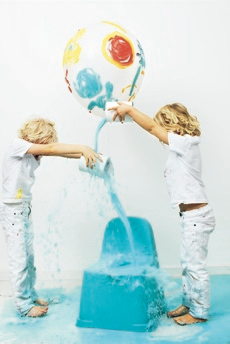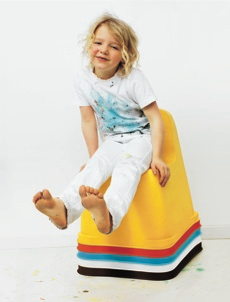Backed by a renowned trio of designers, a children’s chair is being launched at the Milan Furniture Fair on April 22 to 27. The innovative piece of furniture is made of DuraPulp, a pulp that has been developed by Södra Cell R&D. The chair is durable and waterproof, despite having the look and feel of ordinary paper. The material is a speciality pulp combined with PLA, a biodegradable plastic made from maize starch and cane sugar.
 |
| Photos: Denise Grünstein |
In recent years, Södra Cell R&D has been conducting intensive research into materials designed to meet the needs of the future. One of the projects has resulted in an innovative new pulp called DuraPulp. Meanwhile, in another part of Sweden, three architects have been playing with the idea of a piece of furniture made from a completely new, eco‐friendly material. And the story may well have ended there.
Instead, the two creative processes came together thanks to Joakim Nygren, an ambitious design and product development student at the Royal Institute of Technology in Stockholm. With his thesis in mind, he wanted to take part in developing a chair in collaboration with an industrial company or a firm of established furniture designers.
When Nygren was given a trainee position at internationally renowned architect firm Claesson Koivisto Rune he contacted STFI Packforsk – the Swedish pulp and paper research organisation, which in conjunction with Södra, could make the project a reality. The unique partnership began to gain momentum, and a new children’s chair in an innovative material began to emerge.
Architect Mårten Claesson talks about his fascination for the material used in the chair. He explains the advantages it has in being a light, stable, cheap and thoroughly natural material. “The real innovation is in the component known as PLA, Polylactic acid, which is what adds strength to the pulp composite. PLA is a polymer based on lactic acid from maize, which means the product can be fully composted,” he says. He compares DuraPulp with the material used to make egg cartons. “If you step on an egg carton it squashes down to nothing – even though it can protect something as fragile as an egg throughout the entire transport chain. It is the carton’s shape that creates durability, which is an exciting concept,” he says.
When the designer trio gave form to the chair, they based it on their philosophy: to let the assumptions create the form as far as possible. Mårten says that the chair’s appearance has largely been decided by its function. “Parupu has more or less designed itself – under our supervision. We have added our skills and experience and combined this input with the technical possibilities the material provides. Joakim has been invaluable with his calculations and tests,” he says.
It was also the designer trio’s idea to launch the chair, which is named Parupu, at the furniture fair in Milan in April. Thérèse Thelin, head of Södra Cell’s marketing and coordinator of the Milan exhibition for the team, discusses the 72 square‐metre Södra display. “We’re hoping to attract the interest of people and companies that are interested in new materials. Södra’s participation shows that we are an innovative pulp supplier that is open to new opportunities,” she says. Mårten Claesson is convinced the Milan fair will have a strong impact. He considers it the perfect arena to present such an innovative design project as Parupu – from a material as well as a design perspective.
 “Here you reach designers that are interested in material innovation. And we shouldn’t play down the fact that the world press is there, and will undoubtedly want to talk about the new material. Pulp is new in these circles,” he says. Thérèse explains that Södra will be distributing information cards and posters made of DuraPulp, which means they perform a double service as material tests. A book will also be available for people wanting to learn more.
“Here you reach designers that are interested in material innovation. And we shouldn’t play down the fact that the world press is there, and will undoubtedly want to talk about the new material. Pulp is new in these circles,” he says. Thérèse explains that Södra will be distributing information cards and posters made of DuraPulp, which means they perform a double service as material tests. A book will also be available for people wanting to learn more.
In response to why they chose a children’s chair to embody DuraPulp, Claesson, Koivisto and Rune explain there are very few designer children’s chairs on the market. “There is an abundance of designer adult chairs, but hardly any targeted at children. And there is also a strong symbolic value in the fact that a chair designed for a childhood is designed to have a limited life. It is not everlasting; it should be used and composted. You could say that we have taken up the old disposable consumer attitude but added a new, ecological approach.”
He adds: “What’s more, Parupu is multifunctional. You can sit on it, draw on it, make towers with it. It is stackable for easy transportation, there’s no reason to transport air when you donʹt have to.ʺ
Mårten Claesson is very pleased with the collaboration. “It has been hugely stimulating to work with such a future‐oriented and resourceful organisation as Södra, the response has been fantastic. But it is important to recognise that DuraPulp is not just a material for making children’s chairs. The children’s chair is an introduction of the material’s possibilities.”
Technical Director and R&D Manager Karin Emilsson has high expectations for the exhibition and hopes that Parupu will attract a great deal of attention – something she believes is well worthwhile. She explains that Parupu is the first demonstration of this new type of material, which consists 100 per cent of renewable cellulose. “DuraPulp is also suitable for making quality packaging and labels, and runs perfectly well in a normal paper machine. Our hope is that the chair will create interest and ideas amongst our existing customers as well as leading to discussions with new customer groups and new markets,” she says.
Parupu means pulp in Japanese. The name is a tribute to a culture where an inherent feeling for the properties of paper has resulted in attractive and functional products being produced for many centuries.
Further information
Project website www.sodrapulplabs.com
Contact
Per Braconier, Corporate Communications
Södra
Tel.: 0046-470 856 23
Mobil: 0046-705 34 51 66
Joakim Nygren , Project Manager
Tel.: 0046-707 77 12 20
Patrick Coan, Manager of Communication
Claesson Koivisto Rune
Tel.: 0046-86 44 58 63
Source
Södra, 2009-04-02.
Supplier
Share
Renewable Carbon News – Daily Newsletter
Subscribe to our daily email newsletter – the world's leading newsletter on renewable materials and chemicals













